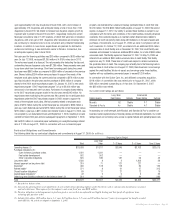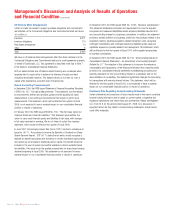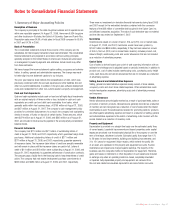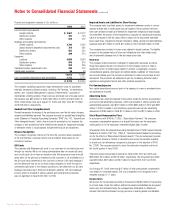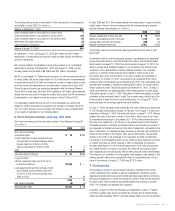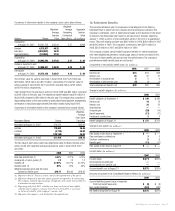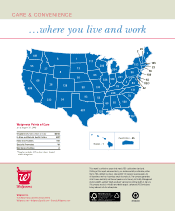Walgreens 2008 Annual Report Download - page 31
Download and view the complete annual report
Please find page 31 of the 2008 Walgreens annual report below. You can navigate through the pages in the report by either clicking on the pages listed below, or by using the keyword search tool below to find specific information within the annual report.
and their respective tax bases. Deferred tax assets and liabilities are measured
pursuant to tax laws using rates we expect to apply to taxable income in the
years in which we expect those temporary differences to be recovered or settled.
The effect on deferred tax assets and liabilities of a change in tax rate is recognized
in income in the period that includes the enactment date. Valuation allowances are
established when necessary to reduce deferred tax assets to the amounts more
likely than not to be realized.
In determining our provision for income taxes, we use an annual effective income
tax rate based on full year income, permanent differences between book and tax
income, and statutory income tax rates. The effective income tax rate also reflects
our assessment of the ultimate outcome of tax audits. Discrete events such as audit
settlements or changes in tax laws are recognized in the period in which they occur.
We are subject to routine income tax audits that occur periodically in the normal
course of business. U.S. federal, state and local and foreign tax authorities raise
questions regarding our tax filing positions, including the timing and amount of
deductions and the allocation of income among various tax jurisdictions. In evaluating
the tax benefits associated with our various tax filing positions, we record a tax
benefit for uncertain tax positions using the highest cumulative tax benefit that
is more likely than not to be realized. Adjustments are made to our liability for
unrecognized tax benefits in the period in which we determine the issue is effectively
settled with the tax authorities, the statute of limitations expires for the return
containing the tax position or when more information becomes available. Our liability
for unrecognized tax benefits, including accrued penalties and interest, is included
in other long-term liabilities on our consolidated balance sheets and in income tax
expense in our consolidated statements of earnings.
We adopted the provisions of FASB Interpretation (“FIN”) No. 48, “Accounting for
Uncertainty in Income Taxes – an Interpretation of FASB Statement No. 109,”
effective September 1, 2007. FIN No. 48 provides guidance regarding the recognition,
measurement, presentation and disclosure in the financial statements of tax positions
taken or expected to be taken on a tax return, including the decision whether to
file or not to file in a particular jurisdiction.
Earnings Per Share
The dilutive effect of outstanding stock options on earnings per share is calculated
using the treasury stock method. Stock options are anti-dilutive and excluded from
the earnings per share calculation if the exercise price exceeds the market price
of the common shares. Outstanding options to purchase common shares of
12,962,745 in 2008, 6,943,454 in 2007 and 3,505,834 in 2006 were excluded
from the earnings per share calculations.
Interest Expense
The company capitalized $19 million, $6 million and $3 million of interest expense
as part of significant construction projects during fiscal 2008, 2007 and 2006,
respectively. Interest paid was $30 million in fiscal 2008 and $7 million in 2007.
Accumulated Other Comprehensive Income (Loss)
In August 2007, the company adopted SFAS No. 158, “Employers’ Accounting for
Defined Benefit Pension and Other Postretirement Plans – an Amendment of FASB
Statements No. 87, 88, 106 and 132(R).” In accordance with SFAS No. 158, the
amount included in accumulated other comprehensive income (loss) related to
the company’s postretirement plan was a loss of $20 million pre-tax (income of
$9 million after-tax) as of August 31, 2008. The minimum postretirement liability
totaled $371 million as of August 31, 2008.
2. Leases
The company owns 19.9% of its operating locations; the remaining locations are
leased premises. Initial terms are typically 20 to 25 years, followed by additional terms
containing cancellation options at five-year intervals, and may include rent escalation
clauses. The commencement date of all lease terms is the earlier of the date the
company becomes legally obligated to make rent payments or the date the company
has the right to control the property. Additionally, the company recognizes rent expense
on a straight-line basis over the term of the lease. In addition to minimum fixed
rentals, most leases provide for contingent rentals based upon a portion of sales.
Minimum rental commitments at August 31, 2008, under all leases having an initial
or remaining non-cancelable term of more than one year are shown below
(In millions):
2009 $ 1,843
2010 1,961
2011 1,960
2012 1,929
2013 1,890
Later 23,883
Total minimum lease payments $33,466
The above minimum lease payments include minimum rental commitments related
to capital leases of $69 million at August 31, 2008. This capital lease amount
includes $28 million of executory costs and imputed interest. Total minimum lease
payments have not been reduced by minimum sublease rentals of approximately
$37 million on leases due in the future under non-cancelable subleases.
The company remains secondarily liable on 21 assigned leases. The maximum
potential of undiscounted future payments is $12 million as of August 31, 2008.
Lease option dates vary, with some extending to 2015.
Rental expense was as follows (In millions):
2008 2007 2006
Minimum rentals $1,784 $1,614 $1,428
Contingent rentals 13 16 16
Less: Sublease rental income (10) (11) (12)
$1,787 $1,619 $1,432
3. Acquisitions
Business acquisitions in 2008 include the purchase of I-trax, Inc., a provider of
worksite health services, including primary and acute care, wellness, pharmacy and
disease management services and health and fitness programming; Whole Health
Management, a privately held company that provides primary care, urgent care,
wellness programs, health coaching and occupational health services through
worksite health centers; 20 drugstores from Farmacias El Amal; CuraScript Infusion
Pharmacy, Inc., a home infusion services provider; and selected other assets
(primarily prescription files).
The aggregate purchase price of all business and intangible asset acquisitions in fiscal
2008 was $620 million. These acquisitions added $152 million to prescription files,
$73 million to other amortizable intangibles, and $416 million to goodwill ($31 million
is expected to be deductible for tax purposes). The remaining fair value relates to
tangible assets less liabilities assumed. The allocation of the purchase price
for each of these acquisitions, except I-trax, Inc. and Whole Health Management,
has been finalized.
2008 Walgreens Annual Report Page 29




